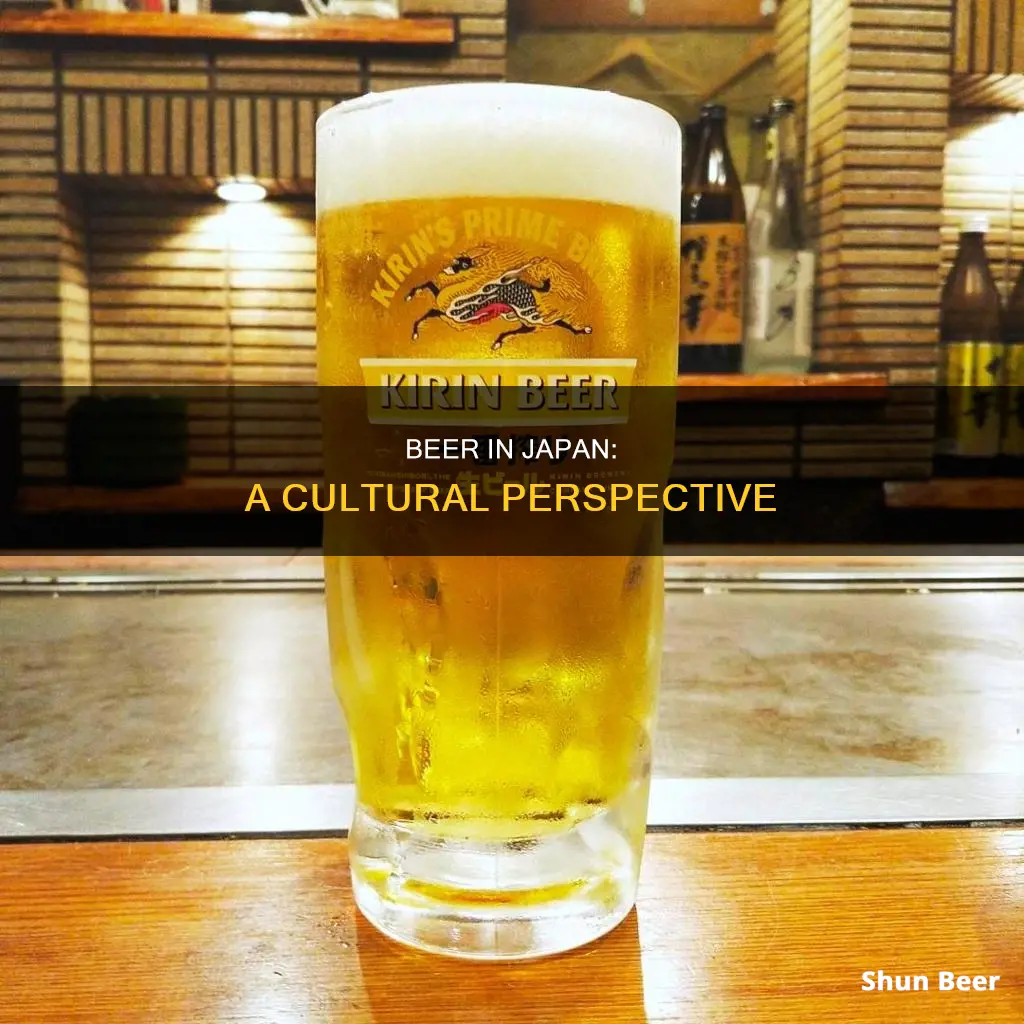
Japan's drinking culture is a blend of tradition and modernity, with alcohol playing a significant role in social and business interactions. Beer is the most popular alcoholic drink in Japan, widely consumed at homes and drinking establishments. The country's four main beer producers are Asahi, Kirin, Sapporo, and Suntory, with most drinkers preferring light lagers. However, the craft beer scene is on the rise, offering a wider variety of beers to suit different tastes. Beer is typically enjoyed as a starter during social gatherings, and it's common for Japanese people to drink with colleagues in an event called nomikai or nominication, which helps foster open communication and strengthen work relationships.
| Characteristics | Values |
|---|---|
| Most popular alcoholic drink in Japan | Beer |
| Beer producers | Asahi, Kirin, Sapporo, and Suntory |
| Beer type | Light lager |
| Alcohol content in light lager | Around 5% |
| Other types of alcoholic drinks | Sake, Shochu, Whisky, Umeshu, Happoshu, etc. |
| Drinking culture | Nomikai, or drinking parties, are common for social and professional bonding |
| Drinking etiquette | Never pour a drink for yourself, always have food with your drinks, don't drink before everyone has their drink |
| Legal drinking age | 20 |
| Public drinking laws | Lax; legal to drink open alcohol in parks, stations, and trains |
What You'll Learn

Japanese drinking etiquette
Drinking is an important part of Japanese culture, both socially and in business. It is seen as a way to build trust and strengthen relationships, and to express honesty. The Japanese drinking culture has its own set of rules and customs that are considered important to follow. Here are some key points of Japanese drinking etiquette:
Before the Toast
Punctuality is important in Japan, so it is considered rude to arrive late to a drinking gathering. It is best to arrive around ten minutes early. When you enter, greet people quietly and respectfully, and take a seat near the entrance, which is called the shimoza. The kamiza, or seat furthest from the entrance, is reserved for higher-ranking members.
The Toast
Wait for everyone to have their drinks before starting, and never pour a drink for yourself. It is customary to wait for someone to give you a drink, and the first drink is poured for everyone simultaneously. The traditional toast is "kanpai", which means "cheers" and translates to "empty cup" or "bottoms up". It is customary to make eye contact with those around you as you raise your glass. If there are seniors or superiors present, hold your glass at a lower angle than theirs.
During the Gathering
Pay attention to the drinks of those around you, and offer to pour a drink for anyone whose glass is empty. If your glass is empty, wait for someone to ask if you want a refill. It is considered casual to pour a drink for yourself in front of a senior or superior. To pour a drink for someone else, hold the bottle with both hands, ensuring the label faces up, and support the centre of the bottle with your left hand. The person receiving the drink should hold their glass at a slight angle to facilitate the refill. It is customary to initially refuse the drink as a humble gesture, and the person pouring will usually insist.
When You Leave
Wait for the host or a superior to decide when the party is over. Departing early can be considered rude, and it is also important to ensure you do not leave someone else with the bill. If you must leave early, inform the host in advance and make arrangements for payment. Offer to help with cleaning up, thank your hosts, and ensure you do not leave any belongings behind.
Beer, Constipation, and You: The Surprising Truth
You may want to see also

Beer's arrival in Japan
Beer is now the most popular alcoholic drink in Japan, but its history in the country is relatively recent.
The arrival of beer in Japan is thought to date back to the 17th century, during the Edo period, when it was introduced by Dutch traders. However, it was not widely available until the end of the 19th century, when the Treaty of Kanagawa in 1854 opened Japan to foreign trade. Even then, it was not always popular; one Japanese official described the beer presented by Commodore Matthew Perry at Kanagawa as tasting like "bitter horse piss".
In 1853, a Japanese scholar named Kawamoto Komin successfully test-brewed beer for the first time in Japan. He was a scientist and translator who was impressed by the beer-brewing process he found described in a Dutch book.
In 1869, the Yokohama Brewery was established as the first beer brewery in Japan. It was founded by a man named Rosenfeld, who was not Japanese and had a Jewish background. At this time, most beer production in Japan was conducted by foreigners, as it was not widely recognised and accepted by Japanese people.
In 1870, another brewery, the Spring Valley Brewery, was established in Yokohama by an American brewer, William Copeland. Their beer quickly became popular among foreigners living in the area, and they soon began exporting it to other countries. The same year, an American, W. Copeland, founded the brewery that would become the Kirin Brewery Company in Yokohama.
In 1872, Shibutani Beer, founded by a Japanese man, Shibutani Shozaburo, opened in Osaka. Although the business closed in 1881, Shozaburo is credited as the first Japanese brewer and seller of beer. Japan's first beer garden was also built around the same time by Copeland, located next to his brewery.
In 1876, the Hokkaido Kaitakushi Beer Brewery, the first brewery under governmental management, was established in Sapporo, Hokkaido. The Sapporo Brewery was founded as part of a government-directed development plan for Hokkaido.
By the 1890s, the Japanese beer industry was experiencing a period of great prosperity. The Osaka Beer Brewing Company was founded in 1889, and the launch of the Asahi Beer brand in 1892 marked the beginnings of what would become one of Japan's biggest breweries.
In the 20th century, beer consumption in Japan was influenced by a number of factors. During World War II, restrictions on the use of rice for making sake boosted beer consumption, and by the 1950s, beer was Japan's most popular alcoholic drink. However, during World War II, alcohol service in shops and restaurants was restricted, and beer prices were controlled by the government. There was also a decrease in the production of essential beer ingredients such as barley and hops.
After World War II ended in 1945, Japan's beer sales recovered thanks to a new policy that allowed people to serve beer freely at shops and restaurants. Beer halls that had been forced to close during the war resumed business. From the mid-1950s to the early 1970s, Japan experienced high economic growth, and with the invention of the refrigerator, the popularity of beer spread across Japan as a casual alcoholic beverage that could be enjoyed at home.
Drinking Beer on Virginia Beach: What's the Deal?
You may want to see also

Beer's market dominance
Beer is the most popular alcoholic drink in Japan, with four major producers dominating the market: Asahi, Kirin, Suntory, and Sapporo. These companies primarily produce light lager beers with an alcohol content of around 5%. However, the market has evolved in recent years with the emergence of regional craft beers and "beer-like" drinks with reduced malt content.
Market Dominance of Major Producers
Asahi, Kirin, Suntory, and Sapporo have long been the dominant players in Japan's beer market. These companies have established strong brand recognition and enjoy wide distribution across the country. Their beers are typically light lagers, which are well-suited to the preferences of most Japanese beer drinkers.
Impact of Craft Beers and "Beer-like" Drinks
In the mid-1990s, Japan's strict brewing laws were relaxed, allowing small-scale craft breweries to enter the market. This change sparked the growth of the craft beer scene, with microbreweries popping up across the country. These breweries offer a diverse range of beers, catering to varying tastes and preferences.
Additionally, Japanese brewers have introduced "beer-like" drinks, such as happoshu (low-malt beer) and daisan no bīru (third beer), which are taxed differently due to their lower malt content. These drinks offer a more affordable alternative to regular beer and have gained popularity, especially among those seeking a more refreshing option during hot summers.
Market Dynamics and Consumer Trends
The overall alcohol consumption in Japan has been decreasing, particularly among younger generations who are more health-conscious. This shift has impacted the beer market, with consumers becoming more open to trying new varieties and craft beers. Additionally, the rise of non-alcoholic alternatives and the awareness of health risks associated with excessive drinking have contributed to changing consumer preferences.
In response to these market dynamics, the major beer producers have adapted their strategies. For example, Kirin and Sapporo have launched their own craft beer lines, aiming to capture the interest of consumers seeking unique and diverse flavors.
While the major beer producers still hold significant market dominance in Japan, the landscape is evolving. The rise of craft beers and "beer-like" drinks has introduced new options for consumers, shaping the market and providing a more dynamic and diverse drinking culture in the country.
Beer Left Out: Still Drinkable?
You may want to see also

'Sort-of-beer'
Beer is the most popular alcoholic drink in Japan and is widely consumed at home and in drinking establishments. However, due to the country's alcohol laws, which tax beer according to its malt content, Japanese brewers have created "sort-of-beers" that contain less malt and are, therefore, cheaper to sell. These "sort-of-beers" have captured a large part of the market and are known as "happoshu" or "low-malt beer".
Happoshu, or "sparkling alcohol", is a recent invention by Japanese brewers that has a similar flavour and alcohol content to beer but is made with less malt, resulting in a lighter taste. This lower malt content also means that happoshu is taxed differently and is, therefore, more affordable for consumers.
Another type of "sort-of-beer" is the "new genre" or "third beer", which contains no malt at all and is made with pea, soy, or wheat spirits. These drinks are taxed even lower than happoshu, making them even more affordable. The development of these "sort-of-beers" is a response to tax changes that have made regular beer more expensive.
The popularity of these alternative beverages is also driven by demographic factors, as younger consumers in Japan are drinking less beer than previous generations. The market for mass-market beer products is expected to continue declining, while the demand for craft beers and premium imported beers is growing.
While beer remains the most popular alcoholic drink in Japan, the rise of "sort-of-beers" indicates a shift in consumer preferences and a desire for more affordable options. These drinks allow consumers to enjoy the social aspects of drinking without the higher cost of regular beer.
Paleo Diet and Beer: Is It Allowed?
You may want to see also

Beer attractions
Japan has a vibrant drinking culture, with beer being the most popular alcoholic drink in the country. Here are some beer attractions to check out:
Beer Tastings and Brewery Tours
Japan has a lot to offer when it comes to beer tastings and brewery tours. Here are some options:
- Sake Brewery Tour in Takayama : This tour takes place in the historic city of Takayama, which had over 50 sake brewers more than 300 years ago. You will learn about the history of sake brewing in the city and get to visit the oldest and largest brewery.
- Sake Tasting at Local Breweries in Kobe : Kobe's Nada district is one of the biggest producers of sake in Japan, with over 40 breweries. This tour will take you to some of the best breweries in the area, where you can learn about the different types of sake and taste a variety of brews.
- Kyoto Sake Bar and Pub Crawl : Explore the cuisine, sake, and craft beer culture of Kyoto with this tour, which takes you to hidden gems that tourists usually miss.
- Nara - Craft Beer, Sake & Food Walking Tour : With a bilingual local guide, you can explore the off-the-beaten-path attractions of Nara while enjoying craft beer, sake, and local food.
- Shibuya Local Bar and Izakaya Crawl Tour : This exciting bar-hopping tour will take you to the local bars and izakaya (Japanese-style pubs) in the vibrant Shibuya area of Tokyo.
- Osaka Bar Hopping : Join professional DJs as they take you to some great drinking spots in Osaka, including famous clubs.
Craft Beer Scene
Japan has seen a craft beer renaissance in recent years, with more and more craft beer producers and distilleries emerging to compete with the big mass-produced brands. The craft beer industry in Japan is relatively young, but it underwent a massive boom in the 1990s due to a change in regulations that favoured small independent brewers. Today, there are hundreds of craft beer bars and more than 300 craft breweries across the country. Here are some notable craft beer breweries to visit:
- Kiuchi Brewery, Ibaraki: This historic brewery started producing sake in 1823 and only began crafting beer in 1996. Their Hitachino Nest beer range is now available worldwide.
- Yo-Ho Brewing, Nagano: Yo-Ho Brewing set out to create beers for everyday beer lovers and succeeded in creating one of Japan's most popular craft beer lines.
- Minoh Brewery, Osaka: Run by three sisters, this award-winning brewery is known for its experimentation with new flavours and is regarded as one of Japan's most innovative craft beer operations.
- Baird Brewing Company, Shizuoka: Launched in 2001, Baird was once Japan's smallest licensed brewery, but has since expanded across the country thanks to its unique process of making beers unfiltered and fermenting them twice.
- Miyashita Sake Brewery, Okayama: This brewery is famous for its Doppo range, a live-yeast-added craft beer brewed in Okayama's temperate climate.
- Abashiri Beer Brewery, Hokkaido: This brewery started as a research project at the Tokyo University of Agriculture, and they are known for experimenting with colour, adding natural pigments to create a vibrant blue beer.
Beer and Fungal Infections: Is There a Link?
You may want to see also
Frequently asked questions
Yes, beer is the most popular alcoholic drink in Japan, with four major producers: Asahi, Kirin, Sapporo, and Suntory.
Japanese beer drinkers tend to prefer light lagers, but the craft beer scene is growing, and regional beers are becoming more popular.
You must be 20 or older to legally drink in Japan.







